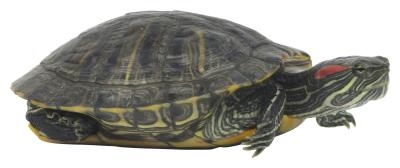
How to Care for & Feed a Pet Turtle. Turtles are not easy pets to care for because each species requires specific care and feeding. Two of the most common types of pet turtles are the red-eared slider and the box turtle. Box turtles usually only grow to about 6 inches long while red-eared sliders can grow to 12 inches long. To have healthy and happy pet turtles, they need to live in environments that resemble their natural habitats and consume a diet that provides all the nutrients they need.

Purchase a glass aquarium or plastic tub to house your turtle. An adult red-eared slider can grow to 12 inches and will require a 55-gal. aquarium or tub, according to the Animal Planet website.
Mimic the slider's natural habitat by including a dry and heated area in the aquarium where the turtle can stay warm. Use smooth rocks or driftwood to create a platform out of the water.
Keep the water temperature in the tank at 75 degrees Fahrenheit and the temperature of the dry area at 85 to 90 degrees Fahrenheit, the Animal Planet website recommends. Use a heat lamp or room heater to achieve the desired temperatures.
Clean your turtle's aquarium routinely to prevent bacteria from contaminating the water. How often you need to clean the tank depends on whether you use a filter and if the turtle is fed in the same aquarium. Always de-chlorinate the water before placing the turtle in the aquarium.
Feed adult sliders every other day and juveniles every day. The Animal Planet website says the slider's diet consists of three categories: commercial foods, animal products and plant products. Less than 25% of the total diet should contain commercial foods such as turtle pellets. Also, less than 25% should contain protein sources including earthworms, feeder fish, snails, crickets or raw lean beef. 50% of the diet should be plant sources such as green beans, collard greens, shredded carrots and fruit.
Create a home for your turtle in a large aquarium or build a cage from plywood. The floor space of the cage should be at least 3 to 4 square feet, according to Dr. Mark Burgess, DVM.
Fill the bottom of the cage with artificial turf and add rocks and plants that the turtle can hide behind. Provide a water bowl big enough for the turtle to lie in. Keep water in the bowl very shallow, no higher than the turtle's chin, according to the Healthy Pet website.
Keep the temperature in the cage around 75-85 degrees Fahrenheit and provide ultraviolent light 12-14 hours each day to imitate natural sunlight, recommends Dr. Burgess. To heat the cage, use a heating pad underneath the artificial turf or a heat lamp above the cage.
Feed juvenile box turtles daily and adults at least 3 times a week. A box turtle's diet consists of 75-85% fruits and vegetables and 15-25% commercial turtle food, states Dr. Burgess. Vegetables can include spinach, kale and dandelions. Only use fruits as special treats.
Copyright © 2005-2016 Pet Information All Rights Reserved
Contact us: www162date@outlook.com